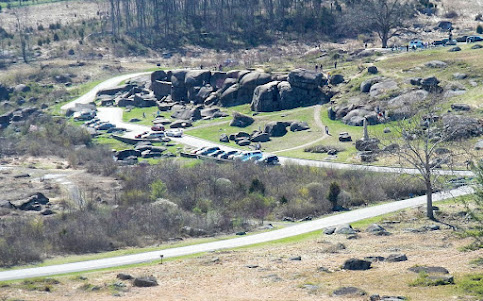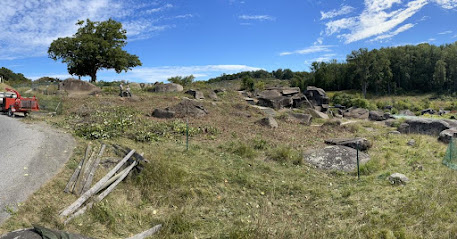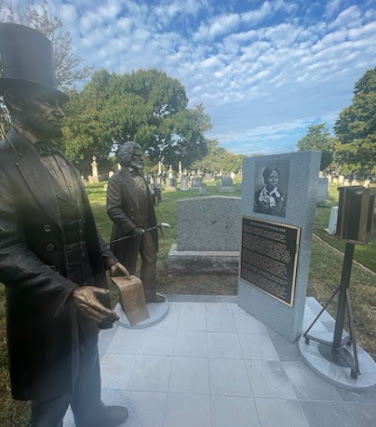 |
| Ceiling rafters and joists will be repaired, left exposed (Photos, Marion Savic) |
You’ve got to
be willing to play the long game – and the expenses that come with it – when
trying to fix up a 200-year-old building that was close to collapsing in a
cloud of dust.
Milan and
Marion Savic and a team of preservation experts are in second and final phase
of the extensive restoration of the Adam Strain building, a tabby structure
that survived the controversial burning of Darien, Ga., during the Civil War.
The Strain,
damaged in the fire, has stood on the bluffs of the small port city since circa
1813. The Savics hope new businesses – a brewery and event space -- will be
open by mid-2023.
Crews stabilized the structure by shoring up the walls and installing tie rods and plates – all aimed at strengthening the
picturesque landmark. They more recently have focused on steel support columns as they move toward shaping the interior space.
 |
| Interior of annex building next to Strain |
“We have
found a great deal of historic artifacts while digging for the footers. Everything
is at the archaeology lab at Coastal Georgia Historical Society on St. Simons
Island,” Marion Savic wrote in a recent email. “They are processing and dating
all the finds. We have found items from Native American periods, 18th century
and 19th century.”
Among the
items found by an archaeological team in 2020 was a Civil War-era bullet -- likely an
Enfield round. The team found it on a bluff that overlooks water, Savic told
the Picket. The so-called Pritchett bullet was used in the Pattern 1853 Enfield
rifle. The rifle was used by both sides during the conflict, and the
Confederacy imported thousands from England.
It’s too
early to surmise how the bullet came to be there, when it was deposited and to
whom it belonged.
The Adam Strain was used to store cotton prior to shipment in 1861 and
1862 before the Union naval blockade clamped down on Georgia’s coast.
By summer 1863, coastal towns
knew that where the Union army was going, emancipation of slaves was soon to
follow. That fact permeated society in Darien. Most of the town’s 500 white
souls had fled before June 11, frightened by the blockade and the deployment of
African-American troops on nearby St. Simons Island.
On that day, Darien was largely vacant.
 |
| Civil War bullet found during 2020 archaeological dig (Marion Savic) |
Darien held little strategic value to the Union,
but Col. James Montgomery, commanding the African-American 2nd South Carolina
Volunteers, supposedly believed it was a safe haven for blockade runners.
He
apparently had another reason for shelling, looting and burning Darien, leaving only a few buildings standing among the charred ruins. The destruction was depicted in the award-winning 1989 film "Glory."
Steven
Smith, site manager for nearby Fort King George Historic Site in 2013
when the Picket first wrote about the town’s burning, said Montgomery “wanted
to make a political statement. Here was a town built on the backs of slaves.”
Montgomery ordered Col. Robert Gould Shaw and the famed 54th Massachusetts
Infantry to participate. While Shaw didn’t mind the looting to help resupply
his troops, he opposed setting the town to torch. He apparently relented under
threat of court-martial.
The Strain survived the fire but much of its interior was destroyed.
 |
| The Adam Strain building before stabilization work began in 2020 |
It was repaired and saw a rebirth for several decades before it was used
for storage following World War II and then shuttered. The Picket first wrote in 2020 about the efforts to save the
building after decades of deterioration. At one point before the Savics’
purchase, it appeared the beloved piece of history might be demolished. Made of oyster shell tabby and stucco, the structure,
one of the oldest in Darien, is beloved by its 2,000 residents.
The Savics,
who have experience in operating retail businesses in metro Atlanta, turned to
an array of contracted historic preservation experts to bring back a building
that was at risk of being toppled by strong winds. The work has often had to break for permits, updated engineering plans and supplies. A Facebook page keeps those interested up to date.
“Covid didn’t
help with material prices and availability. It slowed it down more than we had
anticipated. The building was also in worse shape that we all had thought, though
that wasn’t a surprise,” says Marion Savic. “We expected the worst, so not a
lot of surprises, but definitely some delays and unusual situations regarding
the procurement of materials.”
 |
| Steel support pit showed evidence of fire (Marion Savic) |
The Adam
Strain is one of few tabby structures remaining on the Georgia coast.
Tabby
is a type of cement made from crushed oyster shells and was popular in the
region for several centuries leading up to the Civil War. Stucco is placed on
the exterior to protect it from water damage.
Contractors are installing a steel membrane of columns and beams to support the walls.
“There will be tabby loss when we begin
to straighten and tighten up the steel membrane. The worst spot is on the back
facing west facade. Landmark Preservation is our contractor and they are tabby
experts, so all tabby will be reused if possible and they will make tabby to
replace lost areas,” says Savic. “The entire building will be tabby, either
original or rebuilt, covered with stucco as it is meant to be.”
The Adam Strain will house a brewery on the
first floor and a history center/museum and event space on the second. A
one-story adjoining building, which housed a bank and other businesses, will
house a kitchen, brewing equipment, bathrooms, office and storage.
The museum
will include artifacts and information from the archaeological
dig. It will convey the Strain’s and Darien’s history --
including shrimping, timber and the story of thousands of enslaved people who
were the backbone of the economy in McIntosh and neighboring counties. (At left, these bottles were found beneath floorboards)
The Savics, from Marietta, Ga., want the Strain building to meet requirements for
the National Register of Historic Places and they are pursuing economic
incentives, including federal and state tax credits, available for such preservation.
The property is a contributing resource
to the West Darien National Register Historic District, which was listed in
2001.
According to Rebecca Fenwick with Ethos Preservation, which is working
for the Savics on the project, property owners at the state level can receive a
25% historic tax credit and an eight-year year tax freeze. At the federal
level, the property owners can receive a 20% historic tax credit.
“Tax credits can be taken against hard and soft costs, to include work
on walls, windows, doors, floors, etc. Soft costs that are eligible include
architect's fees, engineer's fees, contractor labor, etc.,” says Fenwick. “Of
course, there are some strings attached, as all work proposed must be reviewed
and meet the Secretary of the Interior's Standards for Rehabilitation.”
“The incentives
acknowledge that historic rehabilitation projects often cost more than other
projects and that historic buildings help tell our collective story and improve
the quality of life of Georgians. Projects are made possible by these
incentives that might not otherwise have the necessary funding to proceed,”
Fenwick says.
“I think the most interesting finds have been the
discovery of additional masonry openings (windows and doors), with the
removal of interior wall cladding," she says.
The preservation of the Strain building, which sits on the
southeast corner of Broad and Screven streets, is just one piece – albeit a
significant one – in any plans to boost the small downtown district, which has
enjoyed a resurgence in recent years.
A new boutique hotel on the river is scheduled to open this
fall and there is new housing in the area. Savic’s husband, son and
daughter-in-law opened The Canopy Restaurant in the historic Emanuel Brown
house in Darien. Marion Savic also cites plans for downtown streetscaping and plans for repaired and expanded docks.
“Everyone is very excited for the completion of the project,
and we hope that things will keep moving along,” she says.




































